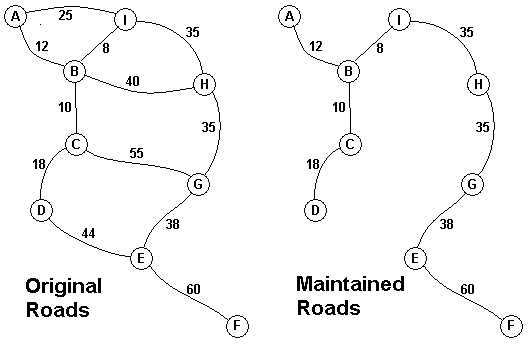POJ-1251 HDU-1301 (最小生成树)
来源:互联网 发布:医生转行知乎 编辑:程序博客网 时间:2024/06/05 20:12
Description

The Head Elder of the tropical island of Lagrishan has a problem. A burst of foreign aid money was spent on extra roads between villages some years ago. But the jungle overtakes roads relentlessly, so the large road network is too expensive to maintain. The Council of Elders must choose to stop maintaining some roads. The map above on the left shows all the roads in use now and the cost in aacms per month to maintain them. Of course there needs to be some way to get between all the villages on maintained roads, even if the route is not as short as before. The Chief Elder would like to tell the Council of Elders what would be the smallest amount they could spend in aacms per month to maintain roads that would connect all the villages. The villages are labeled A through I in the maps above. The map on the right shows the roads that could be maintained most cheaply, for 216 aacms per month. Your task is to write a program that will solve such problems.
Input
The input consists of one to 100 data sets, followed by a final line containing only 0. Each data set starts with a line containing only a number n, which is the number of villages, 1 < n < 27, and the villages are labeled with the first n letters of the alphabet, capitalized. Each data set is completed with n-1 lines that start with village labels in alphabetical order. There is no line for the last village. Each line for a village starts with the village label followed by a number, k, of roads from this village to villages with labels later in the alphabet. If k is greater than 0, the line continues with data for each of the k roads. The data for each road is the village label for the other end of the road followed by the monthly maintenance cost in aacms for the road. Maintenance costs will be positive integers less than 100. All data fields in the row are separated by single blanks. The road network will always allow travel between all the villages. The network will never have more than 75 roads. No village will have more than 15 roads going to other villages (before or after in the alphabet). In the sample input below, the first data set goes with the map above.
Output
The output is one integer per line for each data set: the minimum cost in aacms per month to maintain a road system that connect all the villages. Caution: A brute force solution that examines every possible set of roads will not finish within the one minute time limit.
Sample Input
9A 2 B 12 I 25B 3 C 10 H 40 I 8C 2 D 18 G 55D 1 E 44E 2 F 60 G 38F 0G 1 H 35H 1 I 353A 2 B 10 C 40B 1 C 200
Sample Output
21630
题意:告诉你在岛屿上有n个村庄,还有村庄与村庄间的距离,然后要在这n个村庄间修路,把n个村庄连接起来,用最小生成树解。
1.普里姆算法:
具体代码如下:
#include <iostream> // 普里姆算法#include <cstdio>#include <cstring>#include <algorithm>#include <cmath>using namespace std;#define sc(a) scanf("%d",&a)#define nsc(a,b) scanf("%d %d",&a,&b)#define pr(a) printf("%d\n",a)#define mem(a,x) memset(a,x,sizeof(a))#define lf(i,l,r) for(int i=l;i<r;i++)#define inf 0x3f3f3f3f#define N 510int t,n,m,cnt,x[N],y[N],vis[N];double spot[N][N],num[N],dis[N];void solve(){ int tol; cnt=0; lf(i,1,m+1) dis[i]=spot[1][i]; vis[1]=1; lf(i,1,m) { tol=-1; num[cnt]=inf; lf(j,1,m+1) { if(!vis[j]&&num[cnt]>dis[j]) { num[cnt]=dis[j]; tol=j; } } cnt++; if(tol==-1) return ; vis[tol]=1; lf(j,1,m+1) if(!vis[j]) dis[j]=min(dis[j],spot[tol][j]); } return ;}int main(){ sc(t); while(t--) { nsc(n,m); lf(i,1,m+1) { vis[i]=0; nsc(x[i],y[i]); spot[i][i]=inf; lf(j,1,i) { spot[i][j]=spot[j][i]=sqrt((double)(x[i]-x[j])*(x[i]-x[j])+(y[i]-y[j])*(y[i]-y[j])); } } solve(); sort(num,num+cnt); printf("%.2lf\n",num[cnt-n]); } return 0;}2.克鲁斯卡尔算法:
具体代码如下:
#include <iostream> // 克鲁斯卡尔算法#include <cstdio>#include <cstring>#include <algorithm>#include <cmath>using namespace std;#define sc(a) scanf("%d",&a)#define nsc(a,b) scanf("%d %d",&a,&b)#define pr(a) printf("%d\n",a)#define mem(a,x) memset(a,x,sizeof(a))#define lf(i,l,r) for(int i=l;i<r;i++)#define inf 0x3f3f3f3f#define N 510int t,n,m,cnt,x[N],y[N],p[N];double num;struct node{ int s; int e; double v;} spot[N*N>>1];int Find(int x){ if(x!=p[x]) { p[x]=Find(p[x]); } return p[x];}int cmp(node a,node b){ return a.v<b.v;}void solve(){ int tol=0; num=0; lf(i,1,cnt) { int xx=Find(spot[i].s); int yy=Find(spot[i].e); if(xx!=yy) { p[xx]=yy; tol++; if(tol==m-n) { num=spot[i].v; return ; } } } return ;}int main(){ sc(t); while(t--) { cnt=1; nsc(n,m); lf(i,1,m+1) { p[i]=i; nsc(x[i],y[i]); lf(j,1,i) { spot[cnt].s=i; spot[cnt].e=j; spot[cnt++].v=sqrt((double)(x[i]-x[j])*(x[i]-x[j])+(y[i]-y[j])*(y[i]-y[j])); } } sort(spot+1,spot+cnt,cmp); solve(); printf("%.2lf\n",num); } return 0;} 1 0
- POJ-1251 HDU-1301 (最小生成树)
- HDU 1301 / POJ 1251 Jungle Roads(最小生成树)
- POJ-1251 && HDU-1301 -Jungle Roads [最小生成树]
- 各种最小生成树。 HDU 1863 HDU 1301 POJ 1258
- POJ 1251 HDU 1301 Jungle Roads(kuangbin带你飞 专题六:最小生成树)
- hdu 1301&& ny 434 &&poj 1251 Jungle Roads【最小生成树】
- poj 1251 最小生成树
- poj 1251(最小生成树)
- POJ 1251 最小生成树
- POJ 1251 (最小生成树)
- poj 1251 最小生成树
- HDU 1301 最小生成树
- hdu 1301 最小生成树
- HDU(1301)最小生成树
- hdu 1301 最小生成树
- Poj 2560 || Hdu 1162 Freckles--最小生成树
- HDU 3405 poj 3771 最小生成树+删点
- poj 2421&&hdu 1102 Constructing Roads(最小生成树)
- 去除Visual Studio引号中的内容和注释中出现的波浪下划线
- java集合--ArrayList HashSet HashMap Hashtable LinkList
- cxf3.1.7 + wss4j开发应用
- django 模板加载优化
- BFS 闯迷宫
- POJ-1251 HDU-1301 (最小生成树)
- 动作游戏战斗系统设计综述
- 如何将jsp页面的table报表转换到excel报表导出
- 文件、目录操作
- android 自动弹出软键盘(输入键盘)
- PAT-B 1002. 写出这个数 (20) Stupid!
- ios7,viewcontroller, edgesForExtendedLayout
- 监听手机电话状态改变的两种方法
- java中的修饰符以及作用范围详解图解


